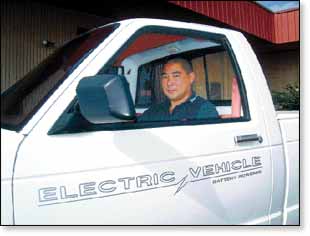If there’s a will, there’s a way. Kaua’i Community College instructor Greg Matsuo says the technology exists today to convert the Puhi campus to run totally on energy collected from the sun. But at this point it would be an
If there’s a will, there’s a way.
Kaua’i Community College instructor Greg Matsuo says the technology exists today to convert the Puhi campus to run totally on energy collected from the sun.
But at this point it would be an expensive proposition, and the commitment to convert may not exist, said Matsuo, an instructor in power energy transportation who oversees a garage full of electric vehicles.
Still, he can envision a campus where the loudest vehicle noise is the one the electric truck makes when the key is turned in the ignition switch and the vacuum pumps that provide power for brakes and other systems fill up, creating a brief humming noise.
After that, the truck is silent, with an array of 20 batteries powering it instead of a gas-guzzling, oil-eating engine.
Matsuo has been meeting with Princeville resident Dave Williams, whose home is energy self-sufficient as a result of a $20,000 system to collect and store the sun’s energy.
On sunny days and even on cloudy ones, the system generates enough power to run Williams’ home plus sell surplus juice to Kaua’i Electric.
If it can work in a residential setting, a system large enough could power KCC. But at today’s prices, it would take a multi-million-dollar system and require rewiring essentially all the buildings for the new source of power, explained Matsuo.
The vision, though, of an energy self-sufficient college lives on a tabletop in one of the shop buildings. A worklight imitates the sun, shining down on photovoltaic panels connected to a system that splits the energy into oxygen and hydrogen, which are then reunited to power a fuel cell that spins a tiny fan.
Matsuo figures if it can work in the workshop, it can happen for the college campus.
Matsuo said he’s learning how much energy the college uses. He’s also meeting with representatives of manufacturers of solar, photovoltaic and co-generation systems that are used in the islands now.
Williams donated the electric pickup to the college, and Matsuo is registering it to be street-legal. The batteries take six to eight hours to charge fully, with several hours of use available from a full charge.
Also in the college’s electric vehicle stable is a van donated by Hawaiian Electric and a peppy bicycle (called an e-bike) that charges in only a few hours and can last a day when supplemented with human pedal-power.
The centerpiece remains the KCC solar race car, Ka’a La O Kaua’i (“sun vehicle of Kaua’i”), which hasn’t actually raced since 1995. Built in 1993, the solar panels and much of the other onboard technology needs to be replaced or modernized, Matsuo said. To race again, it needs new batteries, a new controller, technology modifications and a full systems check.
A team of KCC instructors and students participated in the 1995 Sunrayce on the mainland that drew participants from dozens of major colleges and was won by the University of Michigan.
Matsuo, who holds a bachelor degree in industrial technology and is working on his masters in industrial studies, likes his workplace environment.
“They’ve given me some time to put some things together,” he said.
Staff Writer Paul C. Curtis can be reached at mailto:pcurtis@pulitzer.net or 245-3681 (ext. 224).


